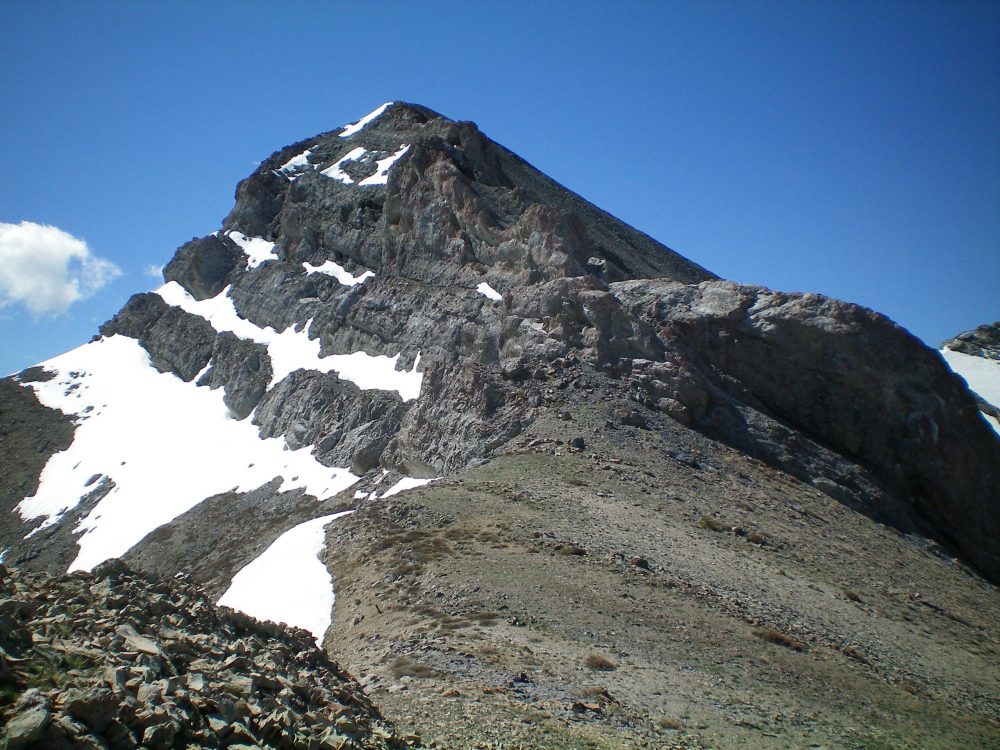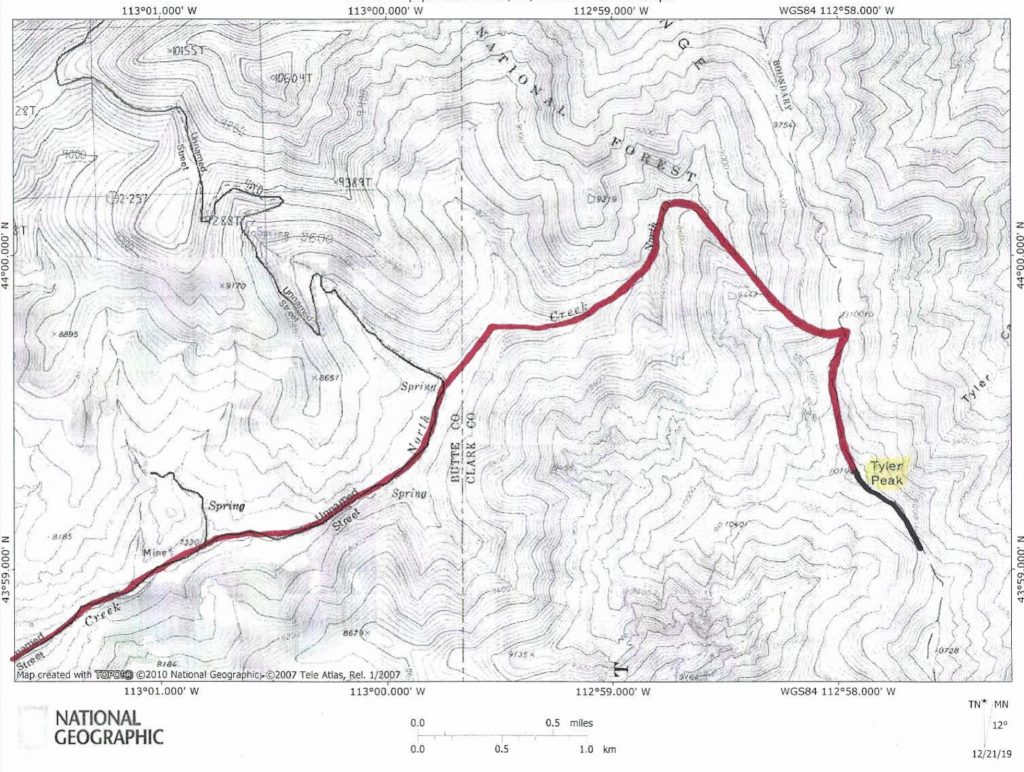Elevation: 10,740 ft
Prominence: 1,080
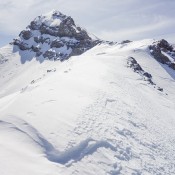
Climbing and access information for this peak is on Page 311 of the book. Larry Prescott and Livingston Douglas contributed the updates set out below. Updated December 2019
Tyler Peak is one of the most impressive summits in the southern Lemhi Range. Larry Prescott completed what is probably the first winter ascent in March 2016. I have excerpted the climbing portion of Larry’s trip report to fully describe and preserve his traverse description. However, use the link below to experience his full trip report below which has much more information and incredible photography. The report is an engaging story of mountaineering pluck and perseverance. A great read. Larry passed away in late October 2016. USGS Tyler Peak
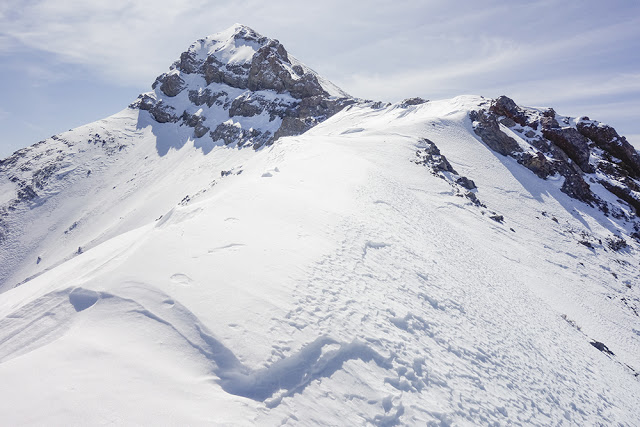
North Creek Route, Class 3 by Larry Prescott
The following is excerpted from Larry Prescott’s trip report: “North Creek is located several miles north of Howe. I always look for the ridge that extends west from the north-south running crest of the Lemhis down to the highway. Once past this landmark, a fenced grave site is on the east side of the road. Passing the grave, start looking for a green street sign marking North Creek. The sign is reflective so it easily seen with high-beam headlights.
Turn east and travel on a county maintained road for six miles to Dave’s house. Park on the right side of the road near Dave’s large storage shed. There is a place to pull off the road here and park. You may be met by Dave’s large red and white Australian Shepard named Clyde. Don’t panic. Clyde is one of the best dogs around and is glad to have your attention. Every time Clyde greets me, it makes my day. I was on the trail heading into the canyon at 7:30AM. The temperature was 16 degrees. The forecast called for a sunny day with temperatures getting barely above freezing. Just what I was looking for after last week’s attempt of Mount Church.
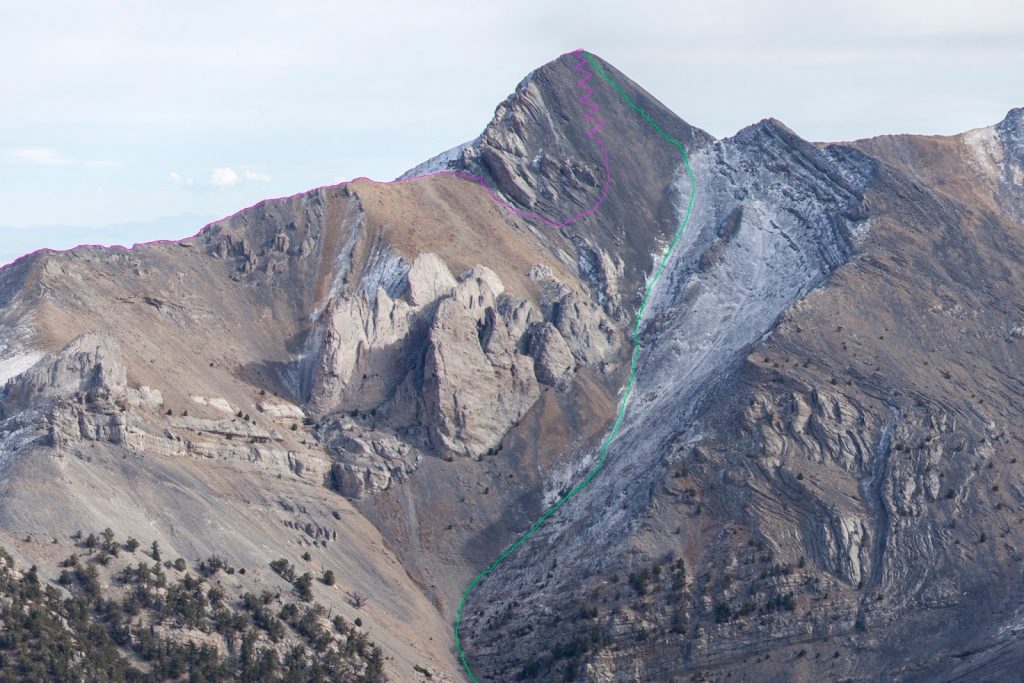
The ascent route (magenta) and descent route (green). This photo was taken from the ridge between Gloved Peak and Shril Benchmark (October 2015). Larry Prescott Photo

Larry was aware of the potential avalanche hazards as he ascended. Larry Prescott Photo
An ATV trail leads deep into the canyon. Once past the foot of Peak 10604, I headed northeast up the drainage. I was looking for a gully which would lead up to the west face of Tyler. Unfortunately, the forest made finding the right turnoff impossible for me. It’s just plain hard to navigate by sight in a thick forest. I was winging this trip without the help of GPS points. I continued up the main well-defined drainage. The snow was fairly good for snowshoes. I remained on top most of the way up this gully. When I did break through, it was often no more than calf deep.”
“I went much farther than anticipated. It was early morning and I was in no hurry. Passed Point 10172 on my left and turned southeast continuing up the main drainage. The sun was breaking the ridge ahead directly in front of me. I had no idea where I was and decided to make the ridge to get a look at my location in relation to Tyler peak. This section was slow and arduous. I was often breaking through snow above my knees, not a happy camper. Walking up the gully, I passed several old avalanche tracts that came down perpendicular to the drainage. Soon I entered the run-out of a large slide that came down the main drainage. Hiking up the debris field, I came to a crown of about two feet. By now the snow had formed a cohesive pack and the danger of avalanche was very slim. I felt confident in the continued ascent. Come Spring, the slides will begin again.”
“Once on the ridge, I was completely surprised to find that I had overshot Tyler Peak. I was on the ridge between Point 10172 and Tyler. Now that I had my bearings, I began the march along Tyler’s north ridge to the summit. Coming up at this location afforded incredible views of the peak. It was worth any extra effort expended to have this view. Trading snowshoes for crampons and poles for an axe, I walked toward the peak. At each bend I was rewarded with more spectacular views of my destination. The route appeared to be quite gnarly as I neared the summit block of layered rock bands. The small dollop of peaked snow on the top added a confectioner’s-like swirl to the crown.”
“Finally made it to the cliffs at the base of the summit block. It looked like it was possible to climb up and through the rocks. It was definitely approaching Class 4 climbing on rock, snow, and ice. I kicked in a few steps and then decided to avoid such a climb. I was not sure, even if I could make the initial pitch, I would find a passage through the top of the rock bands. Also, being alone, I was concerned about keeping myself in one piece for a long descent. I decided to drop off the ridge and skirt the rocks at the base. This was the sketchiest part of the climb. I carefully made my way down the steep, snow-covered slope. A few times the snow was almost waist deep and I was worried about triggering a slide. The run-out was over cliffs! I kept my axe in a constant self belay position and proceeded carefully. I was much relieved to leave the deep snow and round the bottom of the rock band. I snapped a photo of my descent line. For some reason, it seemed a lot steeper than this image makes it out to be. I guess you just had to be there.”

Following the ridge toward the summit block. Larry Prescott Photo
“The next section of the climb was up an incredibly steep scree face with patches of snow and ice. It was so steep that to attack it directly required me to use both hands and feet. I ended up slowly traversing back and forth to reach the summit. It was cool to find a single trail of goat tracks (I think) curved over the summit.”
“Rather than retrace my long route back, I decided to drop down the drainage that I had originally planned to ascend. This would knock some miles off the return hike. I traversed down toward the dip in the ridge leading to Daisy Black and then headed directly down. When I reached the point where all rocks were buried under sufficient snow, I enjoyed a short glissade. Then it was a matter of big steps in soft snow. I knocked off 1,700 feet in an hour. I found myself at the debris tow of a large avalanche field. Rested and again traded my crampons and axe for snowshoes and poles. Then began the long slog over an open section and into the forest. Once I entered the trees, I picked the best looking gully and, once again, slogged on in thigh deep snow down the narrow drainage.”

A shot of the terrain that Larry encountered on the descent. Larry Prescott Photo
“The next part down the narrow gully in deep snow was simply exhausting. I was overjoyed to finally intersect my trail from the morning ascent. Ah, broken trail! This route had whacked off hours off the morning tangent. In two hours, I had managed to converge with my path. I think it was just another hour before I was out in the open of upper North Creek and on the ATV trail. At this point, I turned around to see what I could see. Tyler’s summit and the drainage I descended were framed with trees. Now if I had made that elusive drainage in the morning, I would have cut my time considerably! Yet, the views of Tyler from the north ridge, the sheep, and my sketchy traverse would have never made it into the story.”
Southeast Ridge and North Ridge/North Creek Gully Routes by Livingston Douglas
Southeast Ridge, Class 3
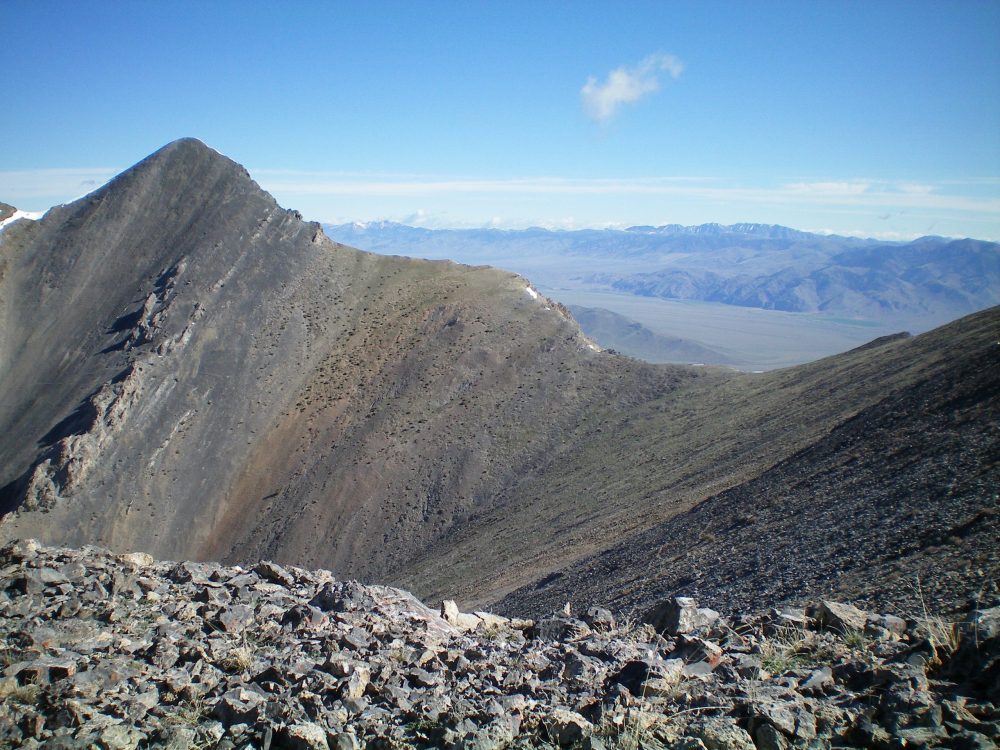
Tyler Peak (left of center) and its choppy southeast ridge (skyline) as viewed from the west ridge of Mount Hoopes. The saddle is the low point between Tyler Peak and Mount Hoopes. Livingston Douglas Photo
Access
Same as for the west gully/west ridge of Mount Hoopes. This route is the final leg of a ridge traverse from Mount Hoopes to Tyler Peak.
The Climb
From the 10,220-foot connecting saddle separating Mount Hoopes from Tyler Peak, scramble up the narrow ridge crest for just over 500 vertical feet to the gentle, broken-scree summit of Tyler Peak. The southeast ridge has a series of ridge steps/cliff bands and rocky outcrops that must be navigated. Skirt the left/west side of any ridge problems to keep the difficulty level at Class 3.
North Ridge/North Creek Gully, Class 4
Access
Same as for the southeast ridge. This is the final leg of a loop route that begins and ends at the mouth of North Creek Canyon.
The Descent
From the summit, carefully descend the loose talus/scree on the narrow ridge crest. Ridge towers soon take over and make it impossible to remain on the ridge crest. Descend the left/west side of these ridge towers on ledges, knobs, and angled scree to continue downward. In a flattish area on the left/west side of the towers (at the head of a prominent northwest gully), do a lateral traverse across a steep face of loose scree to reach the final, and largest, ridge tower. This tower is a diagonal arete that you must cross to get back to the ridge crest. Climb right/east over the crest of the arete/tower and downclimb its right/northeast face to reach the crest of the north ridge. This short downclimb is the crux of the descent and goes at Class 4.
Once below this massive arete/tower, the going is much easier. Follow the rocky ridge north to a gentle saddle south of Point 10010. This saddle is at the head of a side gully that heads northwest and feeds into the upper reaches of the North Creek drainage. Leave the north ridge here and descend this gully down to the North Creek drainage. The initial descent into the side gully is on steep, loose talus. The slope then eases and the terrain becomes a mix of prickly desert brush, downed timber, and loose scree. Farther down, there may be lingering snow in the gully. In addition, there is avalanche debris in the lower part of this gully. Apparently, the side gully serves as an avalanche chute.
As you approach the merger of the side gully and the [main] North Creek drainage, the brush and blowdown becomes quite tedious. Once in the North Creek drainage, follow it through dense forest and brush west then southwest to reach the open terrain of a major fork on the valley floor. The forest opens up and becomes an easy bushwhack as you approach the valley at this fork. You will find an old 2-track road to help you finish this section of the descent. The old road leads west to an unsigned junction with another old 2-track road. Go left/southwest on this old road and follow it a short distance to reach the North Fork ATV Trail at a large meadow and another fork in the valley. Follow the ATV trail back to the mouth of the North Fork Canyon.
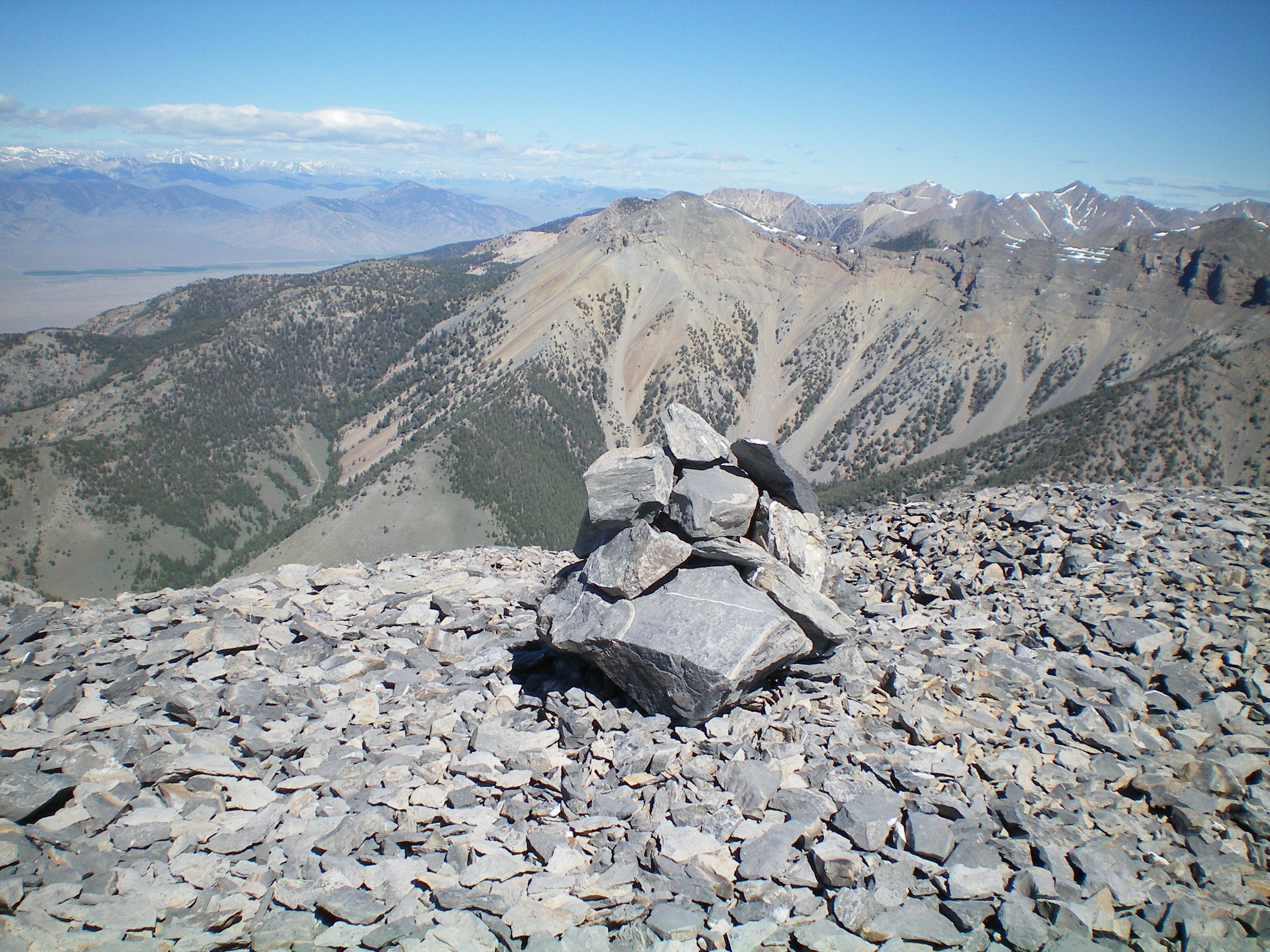
The newly-built summit cairn atop Tyler Peak with Gloved Peak directly behind it in the distance. Livingston Douglas Photo
Additional Resources
Regions: EASTERN IDAHO->Lemhi Range
Mountain Range: Lemhi Range
First Ascent Information:
- Other First Ascent: First Winter Ascent
- Year: 2016
- Season: Winter
- Party: Larry Prescott
- Other First Ascent: Southeast Ridge
- Year: 2019
- Season: Summer
- Party: Livingston Douglas
- Other First Ascent: North Ridge/North Creek Gully —Descent
- Year: 2019
- Season: Summer
- Party: Livingston Douglas
Longitude: -112.96519 Latitude: 43.98839
